Many people, who really should know better given the video resources at their disposal, don't understand what a good swing actually looks like. As a result, they perpetuate a number of myths -- things that you simply don't see in good swings -- about hitting.
Backspin
Backspin is something that many people talk about. They think it is the key to distance. However, and as I explain in my piece on The Myth of Backspin, there is no evidence that backspin is the key to hitting the ball a long way.
Level Swing
One day, I was sitting in Barnes & Noble looking at some books on baseball instruction to see if they were any good or not. I picked up a book entitled Coaching Youth Baseball and flipped through it until I came to the section on hitting.
On page 73 I saw a photo pretty much identical to the one below of Albert Pujols. Its caption read "Proper positioning for the swing." Thinking the author might actually understand what a good swing looks like, I started to read the body text until I came across the line, "The barrel of the bat should be parallel to the ground as it moves through the hitting zone, and the hitter should keep the barrel level with or above the hands during the swing."
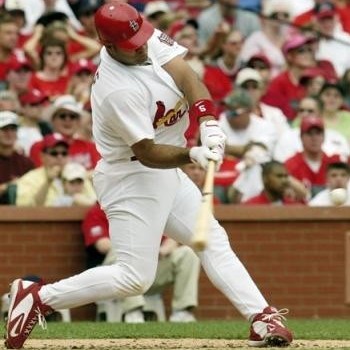
Albert Pujols - Home Run Swing
I don't understand how or why people can say things like that.
Don't they look at the photos in their own books? Do they not understand what the phrase "parallel to the ground" means?
As you can see in the photo above of Albert Pujols, he clearly is not swinging level to the ground. He can't because the pitch is down toward the bottom of the strike zone. Instead, he is Tilting over the plate, which drops the head of the bat down in the strike zone. Oh, and before you say anything let me say that this is a home run swing.
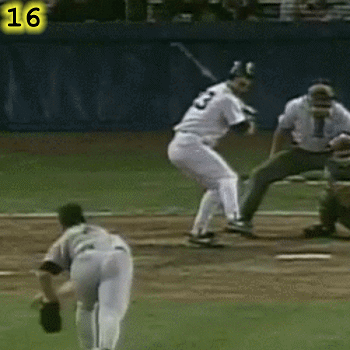
Don Mattingly's Swing
Don Mattingly is also a huge proponent of the level swing but, as the clip above shows, his swing was anything but level to the ground. Notice how he tilts over the plate to get the bat head down to the ball while still maintaining optimal Alignment.
Whenever I encounter someone who preaches the level swing, the first question I ask them is how are you supposed to adjust and hit pitches at the top or bottom of the strike zone while swinging level to the ground?
I find that proponents of the level swing are often new coaches -- fresh out of tee ball, coach pitch, machine pitch, or the first year or two of kid pitch where pretty much every good pitch is a strike right down the middle -- who haven't faced good pitchers who can consistently keep the ball down in the strike zone and who haven't had to think about the concept of Adjustability.
Part of the problem may be that, and as I explain in my piece on the swing from era to era, the game of baseball has changed over the years. In particular, the strike zone has gotten lower over the past 50 to 70 years. While Ted Williams could have been said to have had a relatively level swing, that was because he lived in an era of a relatively higher strike zone. That meant that he was more likely to see balls that were up in the strike and his swing more likely to be level to the ground.
However, hitters now play in a very different era, with a lower strike zone and with pitchers who are taught to keep the ball down in the strike zone and who are more like to miss down in the strike zone than they are to miss up in the strike zone.
The Hands Lead the Hips
The goal of Rotational Hitting is to power the swing with the rotation of the hips and the shoulders (and thus the hands). However, many people teach that the hands should lead the hips. The problem is that that will lead to a weak, arm-y swing, which is why -- and as my pieces on Separation and Sequencing make clear -- good hitters do what Ted Williams said and lead with their hips.
Linear, Direct, A to C Hand Path
Don Mattingly teaches that, since the shortest distance between two points is a straight line, a hitter's hand path should be linear as a result; that the hitter should take their hands directly to the baseball. The problem is that, and as I discuss in more detail in my piece on The Myth of the A to C Swing, that isn't what you see in good swings, including Don Mattingly's swing.
As you can see in my pieces on the Curved Hand Path, Connection, and The L, in a good swing the hands do not move linearly and independently of their back shoulder.
What's more, the position at the Point Of Contact (POC) that Don Mattingly advocates -- with the hands finishing down around the front hip -- and that you see taught by people affiliated with or influenced by him, is what you see in a swing flaw called Dropping The Hands.
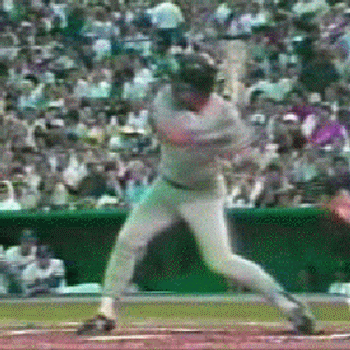
Don Mattingly's Swing
That is why Don Mattingly didn't do what he teaches. Notice how, in the clip above, Don Mattingly's hands finish high and up by his back shoulder and not down by his front hip.
I discuss this very important myth, and describe what a good swing actually looks like, at greater length in my pieces on...
Keep the Barrel Above the Hands
Many people believe that pop-ups are caused by dropping the bat head and swinging with an uppercut. As a result, they teach a swing that chops downward at the ball and that is (supposedly) level to the ground at the POC. However, my video clips...
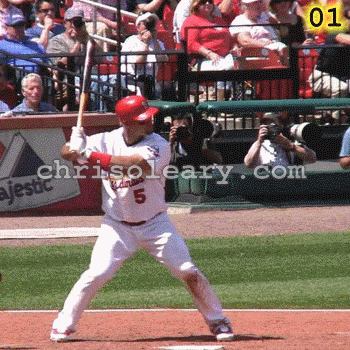
Albert Pujols' Home Run Swing
...and my material on Tilt and the Swing Plane shows that good hitters do not actually keep the bat head above their hands for most of their swing. Instead, they swing with a Slight Uppercut and match the plane of the swing to the plane of the pitch.
Launching the Swing from a Vertical Barrel Position
The number one problem I see in the swings of the higher-level hitters I work with is caused by a myth that I explain in my piece on Launching the Swing from a Vertical Barrel Position.
In short, many instructors and coaches are inadvertently ruining the swings of their hitters by teaching what they think is the swing of Ted Williams, Stan Musial, Barry Bonds, Josh Hamilton, and others.
But it isn't.
Level Shoulders
A cue that is related to the Level Swing cue, and that sometimes has the same goal, is "Level shoulders." It is also sometimes expressed as, "Don't drop your back shoulder." I believe the fear is that, by letting the back shoulder drop, you will let the barrel drop and that will lead to pop-outs. However, and as I have already established above, letting the barrel drop can't be the problem that some people think it is if good hitters like Albert Pujols, Don Mattingly, and every other major league hitter did or do it.

Albert Pujols' Home Run Swing

Don Mattingly's Swing
What's more, the problem with following this cue is that the only way to hit a ball down in the strike zone, while keeping the shoulders level and not letting the back shoulder drop, is to drop your hands. This leads to a weak, arm-y swing, and that's why it's not what Don Mattingly does in the clip above. Instead, what Don Mattingly does is he tilts over the plate, which lets him maintain Connection and Alignment and, rather than just poking the ball, still hit the ball hard.
Swing Down on the Ball (for Backspin)
Good hitters do not swing down on the ball through the point of contact as many people teach. Instead, and because of Tilt, good swings are a slight uppercut with the bat head rising slightly through the point of contact to match the slightly downward plane of the pitch. The result is often a ball, not with backspin, but with little to no spin.
Extension and the Power V at the Point Of Contact
As I discuss in greater detail in my piece on the Misconceptions About Hitting, the concept of Extension is one that many people talk about but that few people seem to really understand.
While some people talk about Extension as something that happens through or after the POC, there are many people out there who teach that hitters should try to reach full Extension at the POC. I assume they believe that because that is what you see in Charley Lau Sr.'s book.
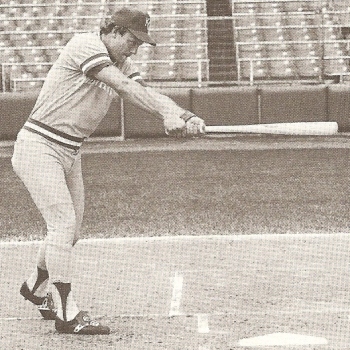
Extension and the Power V at the Point Of Contact
However, if you look at video clips of good hitters, you will rarely see Extension at the POC.

Albert Pujols' Home Run Swing

Albert Pujols' Home Run Swing
There's absolutely no extension at the POC whatsoever in this home run swing by Albert Pujols. Instead, his hands and elbows are close in to his body at POC. Yes, his hands do extend away from his body, but well after the POC.
Unbroken Wrists
Bracing the Barrel at Contact
Hands Ahead of the Barrel at Contact
Like many people, including Ted Williams, Tommy Lasorda teaches that the hitter should make contact with the wrists unbroken, the hands behind the handle, and a 75 to 90 degree angle between the front forearm and the barrel of the bat...
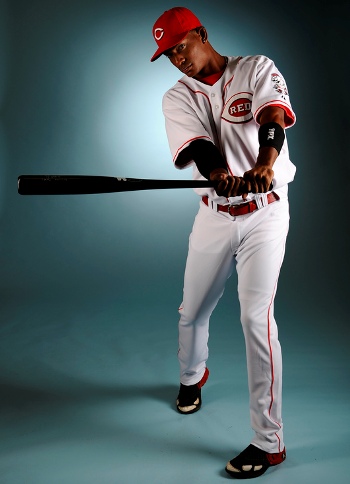
A Terrible Position at the POC
...so that the hands and wrists can brace the barrel and keep it from deflecting back toward the catcher. The problem is that what you see in the photo above isn't what good hitters actually look like at contact.

Albert Pujols' Home Run Swing

Albert Pujols' Home Run Swing
Instead, in most cases the hitter's front arm and the barrel will be in line at contact as the barrel Whips around their hands.
Get Your Front Foot Down Early
Getting the front foot down early, by the time the pitcher releases the ball, is a big point of emphasis of Rudy Jaramillo and others. For instance, at the 5:29 mark of this video clip of a presentation by Ray Tanner of South Carolina and Josh Hamilton, he states that, "When the ball is about to be released, he's going to get his (front) foot down." However, my material on Timing shows that good hitters don't actually do this. Instead, good hitters get their front foot down much later and closer to the POC. That is because the planting of the front heel generally marks the start of the swing, and you don't want to start the swing too soon.
Limited Shoulder Rotation
On a number of occasions I have come across a quote by David Wright where, with respect to the shoulders, he says something to the effect of, "Use your hands and try to allow your shoulders to finish where they started." This quote parallels what I find is a pretty common misconception about what the shoulders do in the swing.
Many people preach, and teach, that the shoulders should (literally) stay in the same place during the swing, or at least through the Point Of Contact, because they believe that is the only way to hit the outside pitch. However, the clip below shows Albert Pujols hitting an opposite field home run on an outside pitch, and I don't see how anyone could say that Albert Pujols' shoulders don't rotate.
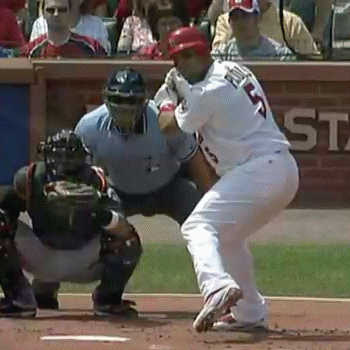
Albert Pujols
Outside Pitch
Home Run
In fact, I have a hard time seeing how the rotation of Albert Pujols' shoulders -- or the rotation of his hips -- is even reduced significantly compared to his swings against inside pitches.
The same is true of the clip below of Jose Bautista hitting an opposite field home run. Notice how much his shoulders rotate, causing the letters on his jersey to rotate into view.
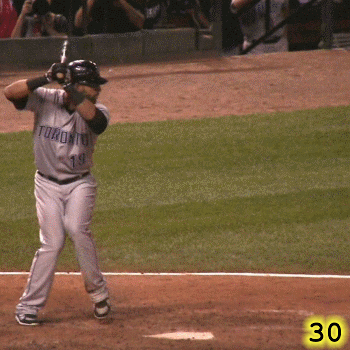
Jose Bautista
Outside Pitch
Home Run
So what's going on with this cue?
It's certainly possible to use the shoulders incorrectly; many kids have a top-down, arm-y, shoulder driven swing that kind of looks like the High-Level Swing but that isn't it.
However, telling hitters to not rotate their shoulders isn't the solution.
Instead, the solution to the problem of a top-down, arm-y, shoulder-driven swing is to teach the hitter about the concepts of Separation and a Resisting Movement and the general importance of getting the hips rotating ahead of the shoulders. The cue to keep the front shoulder in and closed can help increase the odds that the hips will rotate ahead of the shoulders. That can help keep the hands back and the shoulders closed a bit longer so that the hitter can wait on the outside pitch or the off-speed pitch. However, the hitter needs to understand that the shoulders will, and must, eventually rotate open through the Point Of Contact.
Otherwise, all they will be able to do is to swing with their arms, wrists, and hands.
All Together, Now
Some people teach a swing that combines the worst of all worlds; they teach a linear hand path, a level swing, extension at the POC, and squishing the bug. You can find pictures of their students all over the internet and, in a few cases, in the major leagues.
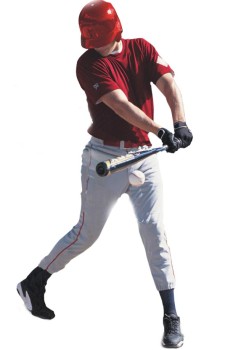
A Terrible Position at the POC

A Terrible Position at the POC
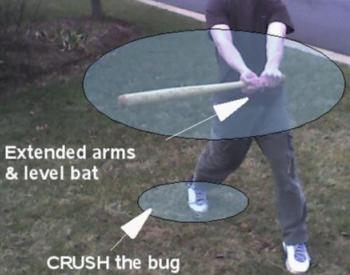
A Terrible Position at the POC
Of course, no good hitter actually looks like this at the POC.